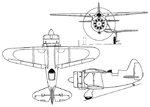One word: Drag!
It increases with the square of the speed, so a biplane would always be slower than a monoplane with the same kind of engine. The second wing would add lift, so if you need a fast climbing interceptor with a moderate speed in level flight a bi-plane might be useful.
It increases with the square of the speed, so a biplane would always be slower than a monoplane with the same kind of engine. The second wing would add lift, so if you need a fast climbing interceptor with a moderate speed in level flight a bi-plane might be useful.

